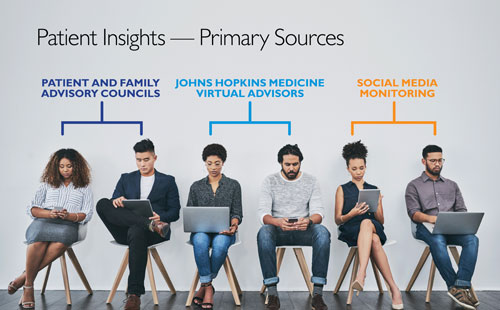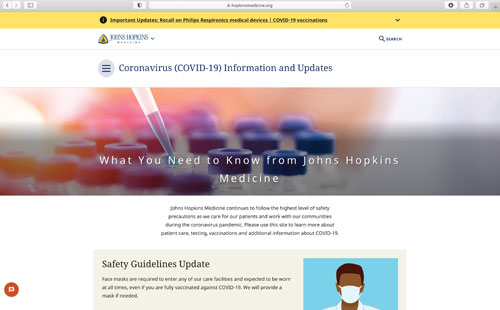MARKETING
For Johns Hopkins Medicine, Leading Starts with Listening
Johns Hopkins Medicine harnesses the power of listening to build consumer trust and lead the way in humanizing brand experiences in health care.
With the consumerization of health care fully underway, organizations across the country are working to humanize the experiences they deliver. According to the Humanizing Brand Experience Report: Volume 4, a study conducted by leading experience company Monigle in partnership with SHSMD and AHA, brands that offer more personalized, “human” experiences see increases in patient satisfaction, loyalty, choice and advocacy.
Based on the report’s comprehensive ranking framework built on a structural equation model (SEM), Johns Hopkins Medicine leads the way in humanizing health care brand experiences, ranking first out of more than 200 hospitals and health systems across the nation. Among the many sensorial, intellectual, behavioral and emotional attributes of experiences that factor into scoring, Johns Hopkins Medicine repeatedly out-performs others, including in essential categories like “Consumer Trust” and “Having the Best People.”
The Power of Listening
According to Suzanne Sawyer, senior vice president and chief marketing and communications officer at Johns Hopkins Medicine, and Kathy Smith, vice president of marketing and communications and senior director of strategic marketing and outreach at Johns Hopkins Medicine, the brand’s experiential success can be traced back to one key theme: listening.
“As a service organization, we’re here to provide care and support, and that has to start with listening,” explains Smith. For Johns Hopkins Medicine, this “culture of listening” is deeply embedded, dating back to its earliest days. Founder William Osler was a passionate advocate for listening to the patient, believing humanity to be an essential component of medicine.
Osler’s early adoption of humanizing principles is still meaningful at Johns Hopkins Medicine today, says Sawyer. “For him, medicine wasn’t just about doing something to someone, but about doing something for someone. That ethos really informs our processes.”
At Johns Hopkins Medicine, listening leads to learning, which in turn drives the implementation of human-centric actions that benefit patients, consumers and communities alike. “These strategies accumulate,” says Sawyer, emphasizing that this orientation to listening played a major role in earning Johns Hopkins Medicine the designation of “Most Trusted Healthcare Brand in the Nation” in 2020.
Operationalizing Listening Strategies While listening is an authentic human trait, it can be challenging for brands and brand leaders to know how to leverage it. According to Smith and Sawyer, there are three top strategies brands should consider as they work toward humanizing experiences:
While listening is an authentic human trait, it can be challenging for brands and brand leaders to know how to leverage it. According to Smith and Sawyer, there are three top strategies brands should consider as they work toward humanizing experiences:
1. Build Channels for Gathering Feedback:
“There is a lot of power in consumer feedback,” says Smith. At Johns Hopkins Medicine, consumer insights are essential to decision-making. Gathering these insights takes many forms, ranging from short surveys to in-depth discussions with patient advisory panels.
Learnings established through these channels directly inform brand actions. “Based on what we’ve learned, we’ve spearheaded initiatives that have helped humanize our patient experience,” says Smith, referencing examples such as updating wayfinding systems to be more intuitive, and personalizing pandemic safety and vaccine content based on patient and consumer feedback and preferences.
While research can be expensive and time-intensive, Smith advises that it doesn’t always have to be, and that there is room for all types of data collection in today’s brand-building. For example, informal surveys allow for instant, low-cost gut-checks. “You can do something quickly, with very low investment, and use it to confirm your decisions or avoid making a mistake,” explains Smith.
2. Leverage Social Listening to Stay Aware:
Online social listening helps Johns Hopkins Medicine stay up-to-date on the latest consumer conversations. This strategy not only helps the brand pinpoint what topics audiences are interested in, but also equips content creators with the language to engage in authentic, responsive dialogue.
“It helps us identify what we should be saying and how we should be saying it,” explains Sawyer. “It’s easy for hospitals to fall into ‘technical speak,’ and there is a time for that, but we try to always keep the patient in mind. Using a human voice contributes to the overall experience.”
In addition to helping Johns Hopkins Medicine keep a pulse on what matters to audiences, social listening has fostered a culture attuned to the kind of communication that benefits its patients and local communities — but the ripple effect doesn’t stop there.
For example, social listening played a significant role in the creation of a Johns Hopkins Medicine coronavirus website in 2020, featuring more than 200 articles, videos and posts, much of it in answer to questions the public was asking. The content was informed by persistent social listening and monitoring search engine trends to know and understand the questions that the public had. Johns Hopkins Medicine responded with a humanistic approach to storytelling that connected millions of seekers with the answers they needed. While the page began as a response to questions posted online by Johns Hopkins Medicine consumers, it quickly grew from there. “The site has attracted more than 69 million visits, and it’s the number one COVID-19 source in the world,” describes Sawyer.
 3. Don’t Forget About Your People:
3. Don’t Forget About Your People:
At Johns Hopkins Medicine, listening extends to employees, too. The brand has established multiple channels for staff to voice feedback and concerns, so that leadership can respond accordingly. “Listening to employees helps us understand what challenges they face, and it helps us create resources for them,” says Sawyer.
Both Sawyer and Smith point to chief wellness officer Dr. Lee Biddison as key to employee listening at Johns Hopkins Medicine. Dr. Biddison heads the office of wellbeing, a team charged with leveraging internal feedback to identify issues and implement solutions.
“During the pandemic, Dr. Biddison’s team was vitally important in helping our faculty and staff,” explains Sawyer. When COVID-19 put immense pressure on workers, the office of wellbeing ensured the organization was proactively hosting conversations about burnout and creating resources to help staff cope.
While internal listening benefits employees, it also benefits the brand as a whole. “Good ideas come from everywhere,” advises Sawyer, “and great strategies for improving experience don’t have to originate from marketing.” Creating space for employee input can be key to identifying new experience innovations.
Johns Hopkins Medicine’s orientation to listening enabled the system to achieve top rankings, make a global impact and set the standard for health care experiences. While their leading scores in the sensorial, intellectual, behavioral and emotional attributes ranked by the Humanizing Brand Experiences report are impressive, Smith and Sawyer emphasize that it all stems from a simple mission: caring for people as authentically as possible.
“That’s really what humanizing the brand is all about for us,” says Sawyer. “It’s about how we show respect to our patients and one another.”
Learning more
- Download the Humanizing Brand Experience Vol 4 report, a unique health care brand experience measurement tool and assessment that highlights consumer needs, available to SHSMD members.
This article features interviews with:
Suzanne Sawyer
Senior Vice President and Chief Marketing and Communications Officer
Johns Hopkins Medicine
Baltimore, Maryland
Kathy Smith
Vice President of Marketing and Communications and
Senior Director of Strategic Marketing & Outreach
Johns Hopkins Medicine
Baltimore, Maryland


